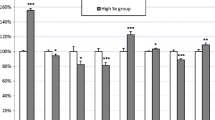Abstract
The relationship between blood lead (Pb) and serum levels of calcium and of neural nutrients such as thiamine and magnesium (Mg) has been determined in a Nigerian population that is occupationally exposed to Pb. Forty-seven male Pb workers were recruited as test subjects and 25 males unexposed to Pb served as controls. The test subjects were classified into three groups, based on severity of exposure to Pb. Blood lead (BPb) and the serum levels of Mg, thiamine, and calcium were determined in both test subjects and controls. The mean blood Pb level was not significantly higher in Pb workers. In contrast, Mg and thiamine levels were significantly decreased (p<0.05; p<0.01, respectively). However, the calcium level was not significantly lower in test subjects than in controls. Also, there was a significant negative correlation between serum thiamine and blood Pb levels (r=−0.50; p<0.01). Furthermore, there was a significant negative correlation between serum calcium and BPb levels (r=−0.41; p<0.01). This study has shown that relatively low BPb levels can enhance Pb absorption and also potentiate Pb neurotoxicity in the presence of decreased serum thiamine and Mg levels.
Similar content being viewed by others
References
C. Marchetti, Molecular targets of lead in brain neurotoxicity, Neurotox. Res. 5(3), 221–236 (2003).
B. Waiker, Neurotoxicity in human beings, Lab. Clin. Med. 136, 168–180 (2002).
D. Soldatovic, V. Matovic, D. Vuganovic, and Z. Stojanovic, Contribution to interactions between magnesium and toxication metals: the effects of prolonged cadmium intoxication on magnesium metabolism in rabbits, Magnesium Res. 11, 283–288 (1998).
A. M. Sepalainen, S. Hernberg, R. Vesanto, et al., Early neurotoxic effects of occupational lead exposure: a prospective study, Neurotoxicology 4, 181–192 (1983).
M. E. Barasi, P. A. Winstanley, and T. Wallen, Human Nutrition: A Health Perspective, Churchill Livingstone, New York, pp. 25–27 (1997).
W. Friedrich, Vitamins, Walter de Gruyer, New York, p. 25 (1988).
L. Zieve, Influence of magnesium deficiency on the utilization of thiamine, Ann. NY Acad. Sci. 162, 732–743 (1969).
Y. Finkelstein, M. E. Markowitz, and J. F. Rosen, Low-level lead-induced neurotoxicity in children: an update on central nervous system effects, Brain Res. Brain Res. Rev. 27(2), 168–176 (1998).
J. Savory and M. R. Wills, Trace metals: essential nutrients or toxins? Clin. Chem., 38, 1565–1573 (1992).
S. Spragues and W. Slavin, A simple method for the determination of lead in blood, Atomic Absorpt. Newslett. 5, 9–10 (1966).
F. J. Bandelin and J. V. Tuschoff, Colorimetric determination of thiamine in pharmaceutical products, Anal. Chem. 25, 1198–2000 (1953).
I. D. P. Wooton and H. Freeman, Microanalysis in Medical Biochemistry, Churchill Livingstone, Edinburgh, pp. 57–58 (1982).
C. K. Mann and J. N. Yoe, Spectrophotometric determination of magnesium, Anal. Chim. Acta 16, 155–160 (1957).
C. Bohuon, Microdosage du magnesium dans divers milienx biologiques, Clin. Chim. Acta 7, 811–817 (1962).
F. A. A. Adeniyi and J. I. Anetor, Lead poisoning in two distant states of Nigeria: indication of the real size of the problem Afr. J. Med. Sci. 28, 107–112 (1999).
R. A. Shakman, Nutritional influence on the toxicology of environmental pollutants, Arch. Environ. Health 28, 105–113 (1974).
K. R. Mahaffery and J. E. Vanderveen, Nutrient toxicant interactions: susceptible population, Environ. Health Perspect. 29, 81–88 (1979).
D. Soldatovic, C. M. Bresjana, and C. Petrovic, Changement due taux du calcium et du magnesium dans i.e. serum desanimaux soumis aux condition d'intoxication chronique parleplombe, Arh. Farm. 1, 1–6 (1965).
G. R. Braton, J. Zmudzki, M. C. Bell, et al., Thiamine (vitamin B1) effects in lead intoxication and deposition of lead in tissues: therapeutic potentials, Toxicol. Appl. Pharmacol. 59, 164–174 (1981).
S. J. S. Flora and S. K. Tandon, Prevention and therapeutic effects of thiamine, ascorbic acid and their combination in lead intoxication, Acta Pharmacol. Toxicol. 58, 374–378 (1989).
S. K. Tandon, M. Chatterjee, A. Bhargara, V. Shuka, and V. Bihari, Lead poisoning in Indian silver refiners, Sci. Total Environ. 17, 257–258 (2001).
C. D. Berdanier, Water soluble vitamins, in: Advanced Nutrition: Micronutrients, CRC, New York, pp. 80–88 (1998).
S. J. S. Flora, S. Singh, and S. K. Tandon, Thiamine and zinc in prevention of lead intoxication, J. Intern. Med. Res. 17, 68–75 (1989).
J. E. Gaius-obaseki, Lead phase out in gasoline in Nigeria, in The World Bank Clean Air Initiative in Sub-Sahara African Cities. National Conference on the phasing out of leaded gasoline in Nigeria. Working paper No. 6, Proceedings: Abuja, Nigeria, The World Bank, Washington DC, pp. 59–61 (2001).
T. E. Kober and G. P. Cooper, Lead competitively inhibits calcium dependent synaptic transmission in the bull frog sympathetic ganglion, Nature (Lond.) 262, 704–705 (1976).
J. L. Anetor, F. A. A. Adeniyi, and G. O. L. Taylor, Neurotoxic implications of some biochemical changes in lead workers, Afr. J. Med. Pharm. Sci. 6, 33–39 (2002).
Author information
Authors and Affiliations
Rights and permissions
About this article
Cite this article
Anetor, J.I., Ajose, O.A., Adebiyi, J.A. et al. Decreased thiamine and magnesium levels in the potentiation of the neurotoxicity of lead in occupational lead exposure. Biol Trace Elem Res 116, 43–51 (2007). https://doi.org/10.1007/BF02685917
Received:
Revised:
Accepted:
Issue Date:
DOI: https://doi.org/10.1007/BF02685917




